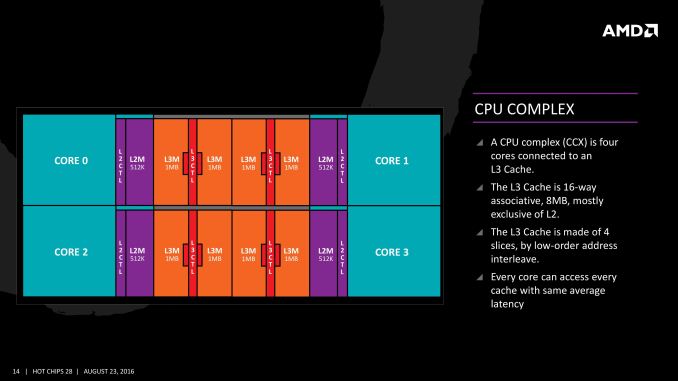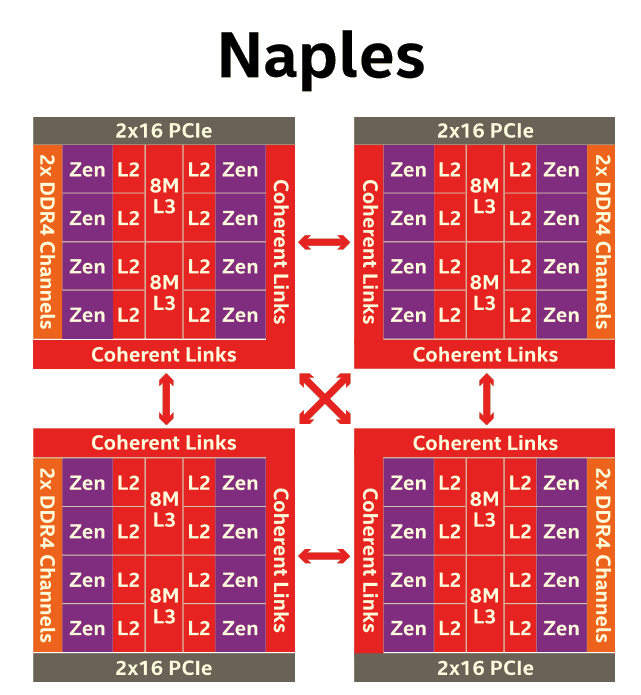Sizing Up Servers: Intel's Skylake-SP Xeon versus AMD's EPYC 7000 - The Server CPU Battle of the Decade?
by Johan De Gelas & Ian Cutress on July 11, 2017 12:15 PM EST- Posted in
- CPUs
- AMD
- Intel
- Xeon
- Enterprise
- Skylake
- Zen
- Naples
- Skylake-SP
- EPYC
AMD's EPYC Server CPU
If you have read Ian's articles about Zen and EPYC in detail, you can skip this page. For those of you who need a refresher, let us quickly review what AMD is offering.
The basic building block of EPYC and Ryzen is the CPU Complex (CCX), which consists of 4 vastly improved "Zen" cores, connected to an L3-cache. In a full configuration each core technically has its own 2 MB of L3, but access to the other 6 MB is rather speedy. Within a CCX we measured 13 ns to access the first 2 MB, and 15 to 19 ns for the rest of the 8 MB L3-cache, a difference that's hardly noticeable in the grand scheme of things. The L3-cache acts as a mostly exclusive victim cache.
Two CCXes make up one Zeppelin die. A custom fabric – AMD's Infinity Fabric – ties together two CCXes, the two 8 MB L3-caches, 2 DDR4-channels, and the integrated PCIe lanes. That topology is not without some drawbacks though: it means that there are two separate 8 MB L3 caches instead of one single 16 MB LLC. This has all kinds of consequences. For example the prefetchers of each core make sure that data of the L3 is brought into the L1 when it is needed. Meanwhile each CCX has its own separate (not inside the L3, so no capacity hit) and dedicated SRAM snoop directory (keeping track of 7 possible states). In other words, the local L3-cache communicates very quickly with everything inside the same CCX, but every data exchange between two CCXes comes with a tangible latency penalty.
Moving further up the chain, the complete EPYC chip is a Multi Chip Module(MCM) containing 4 Zeppelin dies.
AMD made sure that each die is only one hop apart from the other, ensuring that the off-die latency is as low as reasonably possible.
Meanwhile scaling things up to their logical conclusion, we have 2P configurations. A dual socket EPYC setup is in fact a "virtual octal socket" NUMA system.
AMD gave this "virtual octal socket" topology ample bandwidth to communicate. The two physical sockets are connected by four bidirectional interconnects, each consisting of 16 PCIe lanes. Each of these interconnect links operates at +/- 38 GB/s (or 19 GB/s in each direction).
So basically, AMD's topology is ideal for applications with many independently working threads such as small VMs, HPC applications, and so on. It is less suited for applications that require a lot of data synchronization such as transactional databases. In the latter case, the extra latency of exchanging data between dies and even CCX is going to have an impact relative to a traditional monolithic design.













219 Comments
View All Comments
deltaFx2 - Thursday, July 13, 2017 - link
"Can you mention one innovation from AMD that changed the world?" : None. But the same applies to Intel too, save, I suppose, the founders (Moore and Noyce) contributions to IC design back when they were at Fairchild/Shockley. That's not Intel's contribution. Computer Architecture/HPC? That's IBM. They invented the field along with others like CDC. Intel is an innovator in process technology, specifically manufacturing. Or used to be... others are catching up. That 3-yr lead that INtel loves to talk about is all but gone. So with that out of the way...AMD's contributions to x86 technology: x86-64, hypertransport, integrated memory controller, multicore, just to name a few. Intel copied all of them after being absolutely hammered by Opteron. Nehalem system architecture was a copy-paste of Opteron. It is to AMD's discredit that they ceded so much ground on the CPU microarchitecture since then with badly executed Bulldozer, but it was AMD that brought high-performance features to x86 server. Intel would've just loved to keep x86 on client and Itanium on server (remember that innovative atrocity?). Then there's a bunch on the GPU side (which INtel can't get right for love or money), but that came from an acquisition, so I won't count those.
"AMD exists because they are always inferior". Remember K8? It absolutely hammered intel until 2007. Remember Intel's shenanigans bribing the likes of Dell to not carry K8? Getting fined in the EU for antitrust behaviors and settling with AMD in 2010? Not much of a memory card on you, is there?
AMD gaining even 5-10% means two things for intel: Lower margins on all but the top end (Platinum) and a loss in market share. That's plain bad for the stock.
"Intel is a data center giant have head start have the resources...". Yes, they are giants in datacenter compute. 99% market share. Only way to go from there is down. Also, those acquisitions you're talking about? Only altera applies to the datacenter. Also, remember McAfee for an eye-watering $7.8 bn? How's that working out for them?
Shankar1962 - Wednesday, July 12, 2017 - link
Nvidia who have been ahead than Intel in AI should be the more competent threatHow much market share Intel loses depends on how they compete against Nvidia
Amd will probably gain 5% by selling products for cheap prices
Intel controls 98/99% share so it's inevitable to lose a few % as more players see the money potential but unless Intel loses to Nvidia there is annuphill battle for Qualcomm ARM.
HanSolo71 - Wednesday, July 12, 2017 - link
Could you guys create a Benchmark for Virtual Desktop Solutions? These AMD chips sound awesome for something like my Horizon View environment where I have hundreds of 2 core 4GB machines.Threska - Saturday, July 22, 2017 - link
For VDI wouldn't either an APU setup, or CPU+GPU be better?msroadkill612 - Wednesday, July 12, 2017 - link
Kudos to the authors. I imagine its gratifying to have stirred such healthy & voluminous debate :)milkod2001 - Thursday, July 13, 2017 - link
Are you guys still updating BENCH results? I cannot find there benchmark results for RYZEN CPUs when i want to compare them to others.Ian Cutress - Friday, July 14, 2017 - link
They've been there since the launchAMD (Zen) Ryzen 7 1800X:
http://www.anandtech.com/bench/product/1853
KKolev - Thursday, July 13, 2017 - link
I wonder if AMD'd EPYC CPU's can be overclocked. If so, the AMD EPYC 7351P would be very interesting indeed.uklio - Thursday, July 13, 2017 - link
How could you not do Cinebench results?! we need an answer!JohanAnandtech - Thursday, July 13, 2017 - link
I only do server benchmarks, Ian does workstation. Ian helped with the introduction, he will later conduct the workstation benchmarks.